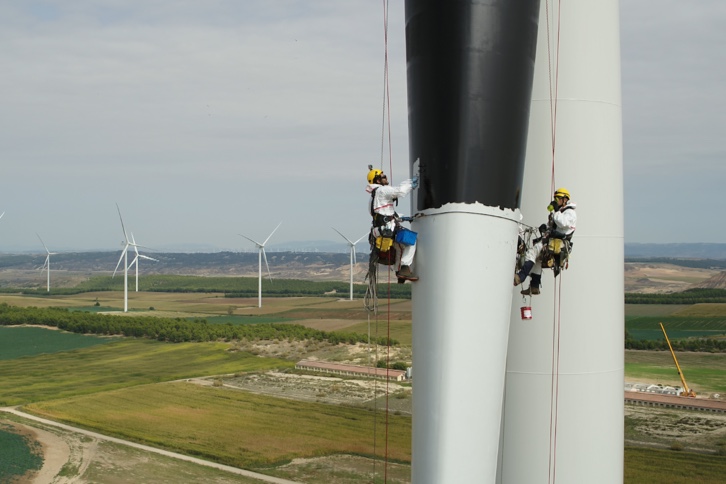Spain – Iberdrola is continuing to develop solutions to support the cohabitation of its renewable facilities, which are one of the pillars of the energy transition, and the ecosystems in which they are located.
The company has started two programs on many wind farms to increase the visibility of their wind turbines and dissuade particular bird species from the zones of impact around the projects. The solutions are based on research undertaken by Norwegian research institutes as well as experiences at French airports.
One such initiative involves the blackening of one of the three blades of multiple wind turbines at wind farms in Cavar (111 MW) in Navarre and Zorreras (20 MW) in Zahara de los Atunes (Cádiz) in Andalusia. The concept, which will be implemented in some of the company’s other wind farms, is based on a research conducted by the Norwegian Institute for Nature Research, which anticipates a 70% drop in the number of birds sighted after implementing this approach. The solution increases the contrast between the blades, making them easier to perceive for birds.
This operation involves sanding, cleaning, and painting the blades of completely built wind turbines 100 meters above the ground. To safeguard the safety of the specialized wind turbine maintenance and operation workers, the jobs are carried out when there is minimal wind and no rain. Each blade on the Cavar wind turbines is 65 meters long and up to 14 meters wide, so painting them can take up to a week.
The second of these attempts involves the application of two vinyl transfers that resemble gazing eyeballs to wind turbine towers. These one-metre-diameter concentric rings are placed between 3.5 and four metres from the wind turbines’ bases. Sticking these black figures to the white base of the wind turbine tower has been demonstrated to discourage birds of prey.
Applying vinyl shapes to wind turbines
The approach was applied in seven Burgos wind farms, involving the application of these vinyl shapes to over 60 wind turbines at the Ballestas-Casetona, Cotera, Páramo Vega, Urbel del Castillo, Valdeporres, Vias, and Fuente Blanca wind farms. The project has no effect on the wind turbine structure and has no effect on the operating systems or electricity produced by these power facilities.
There are plans to construct these vinyl shapes at six more wind farms in Burgos province, with the prospect of expanding the concept being considered.
This strategy has been tried and tested at the airport of Lourdes-Tarbes-Pyrénnés in south-eastern France, and it has proven effective in keeping birds away. When the vinyl shapes were deployed, there was a 66% reduction in the number of birds of prey detected in the airport area.
Iberdrola has fully integrated ecosystem biological diversity conservation into its strategy, demonstrating that a competitive, clean, and sustainable energy supply can coexist in harmony with the environment.
By committing to the net beneficial impact of new infrastructure improvements, the firm hopes to achieve “no net loss” of biodiversity by 2030. In this regard, it has implemented over 1,450 biodiversity-protection measures in the previous three years alone, integrating renewable project development with ecosystem biological diversity conservation and care for flora, animals, and natural assets.
Among other steps to accomplish its environmental targets, Iberdrola has launched the Trees Programme, through which it plans to plant 20 million trees by the end of the decade, capturing around six million tonnes of CO2.




